Messier Monday: A Star-Forming Spiral, M61
Washed out by the full Moon on any other night, the lunar eclipse makes this one visible tonight!
“All is well, provided the light returns and the eclipse does not become endless night. Dawn and resurrection are synonymous. The reappearance of the light is the same as the survival of the soul.” –Victor Hugo
We first started Messier Monday back in 2012, where each week we highlight one of the 110 deep-sky wonders that make up the Messier catalogue, the first accurate, large collection of star clusters, galaxies and nebulae all visible with a small, inexpensive telescope. I’d never showcase today’s Messier object under normal circumstances, as a full Moon would make a nearby galaxy virtually undetectable thanks to light pollution, but tonight’s lunar eclipse — for about 78 minutes, at any rate — will change all of that.
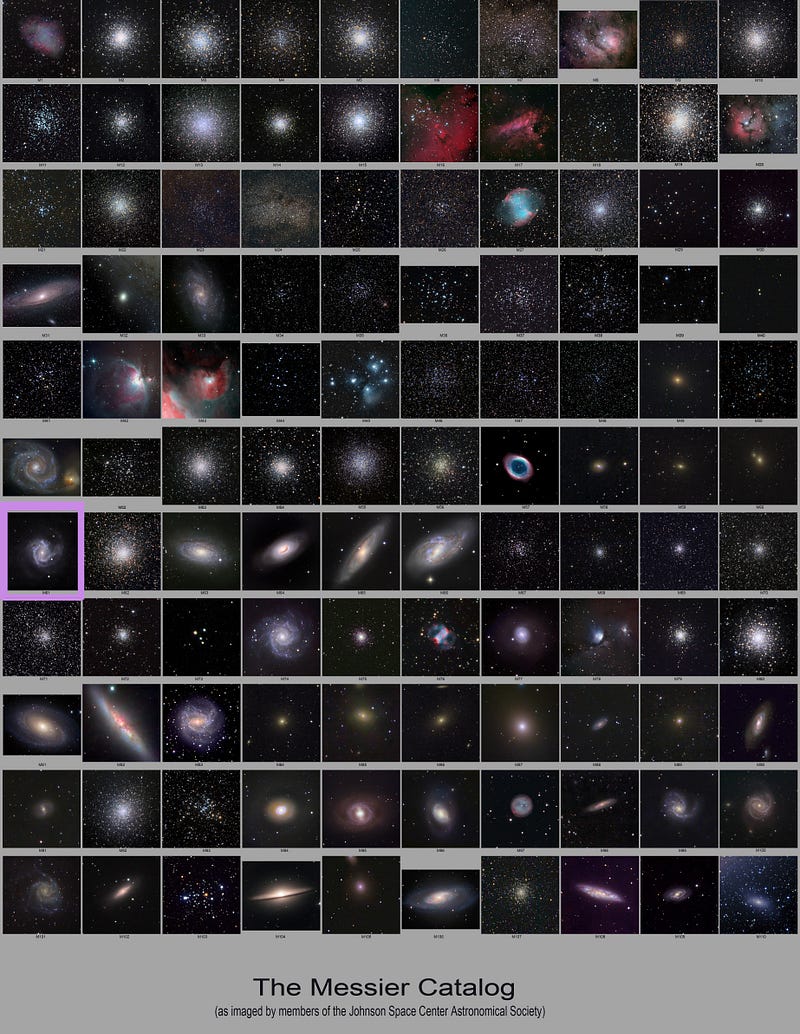
Shortly after sunset at this time of year, the Virgo cluster — the densest nearby collection of galaxies for hundreds of millions of light-years — rises in the sky, presenting thousands of constituent galaxies for our viewing pleasure, including 15 Messier objects. The full Moon hovers nearby, making these galaxies lousy targets for tonight. The full Moon alone is some 400 times brighter than the rest of the night sky combined. The entire night sky without a Moon (or any light pollution) in it would look like a “1” on the scale below; a full Moon is enough to ruin that and turn it into an “8,” even with no other sources of light pollution.
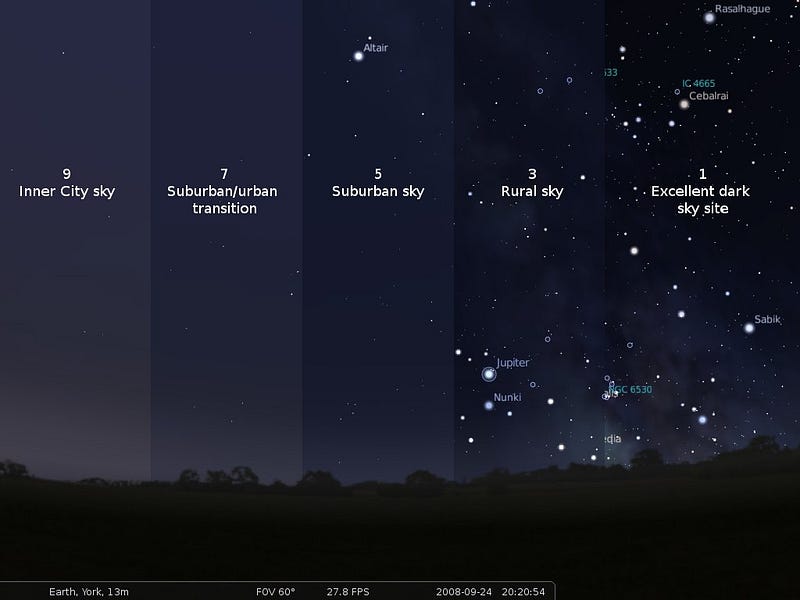
But during a total lunar eclipse, the Moon will not only be significantly less bright than it normally is, it will even be outshone by Mars, which shines at its absolute brightest during last week and this one. And if you look up with your telescope in the region of the Virgo cluster during the eclipse tonight, you’ll be treated to a galactic treat in Messier 61 that will, in fact, be invisible both before and after the eclipse’s duration. Here’s how to find it.
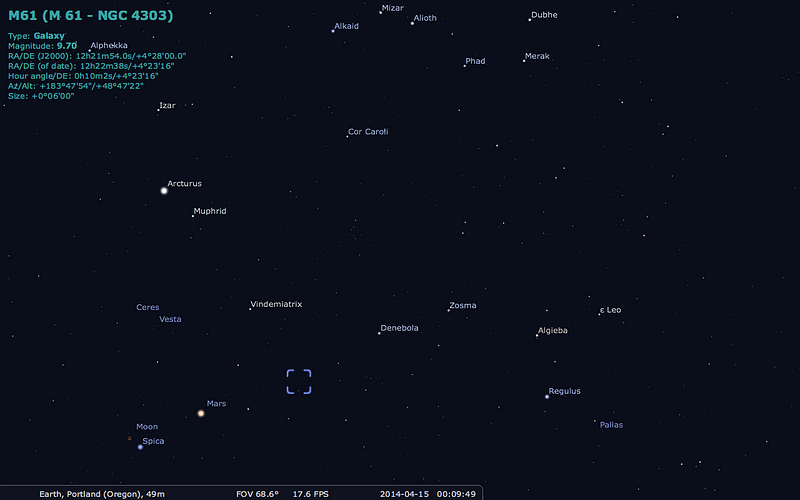
As always, if you can find the Big Dipper, you can follow the “arc” of its handle to Arcturus, the brightest star in the northern hemisphere, and then “speed on” to Spica. The full Moon — whether it’s eclipsed or not — will be hovering right next to Spica, just a degree or two away at most tonight. And nearby is the planet Mars, which reached opposition just six days ago. When the eclipse reaches its maximum amount, Mars will likely outshine the eclipsed Moon, paving the way to view Messier 61, something you can find by navigating from Spica towards Denebola, the second brightest star in the constellation of Leo.
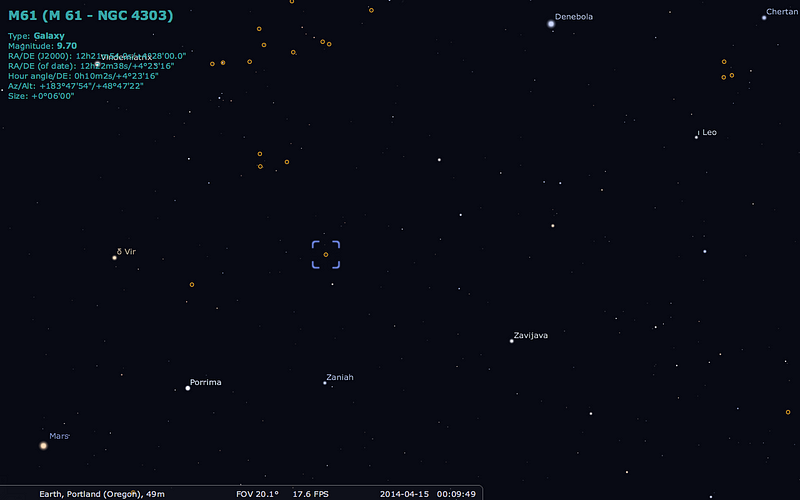
If you continue on from Spica towards Denebola, you’ll run into Mars first, then the bright and prominent Porrima, and then another much less prominent naked-eye star that’s visible just below the blue box above: 16 Virginis. If you can spot this star in a telescope and navigate northwards just about a degree-and-a-half, you’ll run right into Messier 61, tonight’s treat.
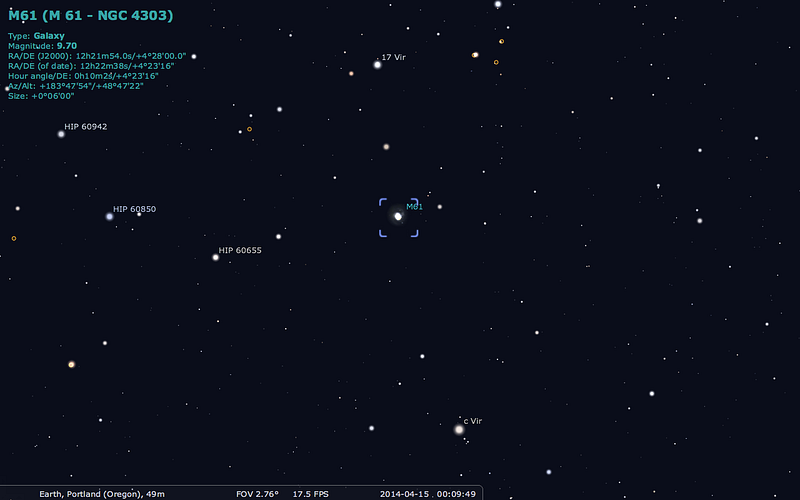
In 1779, there was a comet right in this very region of the sky, and Charles Messier could have found this nebula; he observed it before anyone else. In fact, you may remember that the original purpose of the Messier catalogue was to help skygazers avoid confusing these fixed, deep-sky objects with potential comets, yet that’s exactly what Messier did here! He mistook M61 for a comet, and instead credit for this object’s discovery goes to Barnabus Oriani, who beat Messier to the punch by a mere six days. But 235 years later, it still appears, all but unchanged from how Messier viewed it.
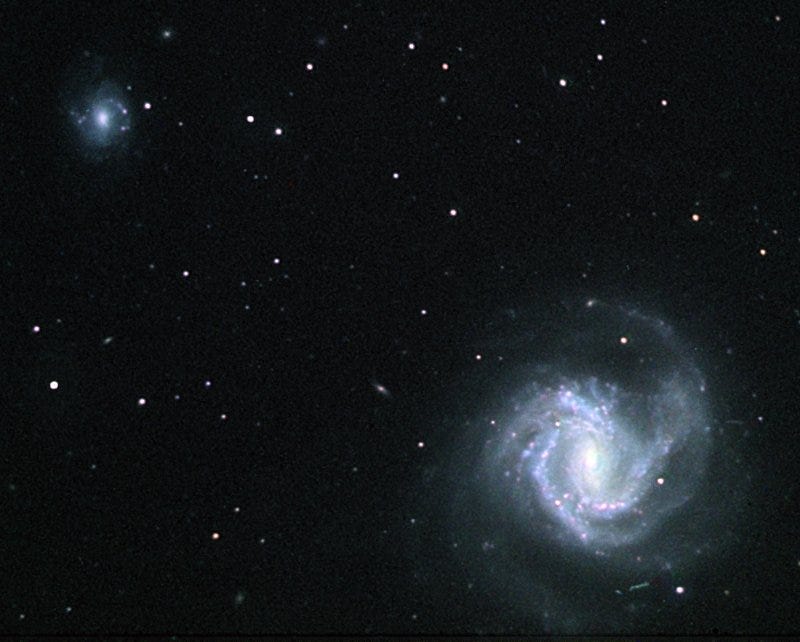
Similar in size to the Milky Way at 100,000 light-years in diameter, this prominent barred spiral galaxy has a number of features that make it rather unusual among Virgo cluster galaxies. For starters, it’s incredibly rich in gas. Most galaxies that are part of a dense cluster like this have had their gas stripped away over time, and resemble something like last week’s galaxy, Messier 58. This gas is evident when we look at two places: the spiral arms and the central core.
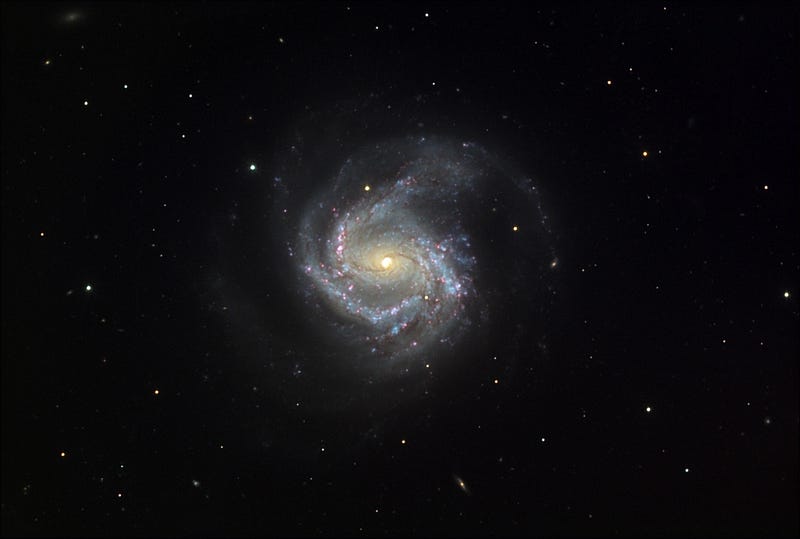
In a gas-rich galaxy, the spiral arms will be littered with star forming regions — visible in pink due to their ionized hydrogen gas — and also with very young, bright blue stars. Well, this is obviously present here, and it could also be intensified by likely gravitational interactions with two nearby, smaller galaxies as well.
But if we move in towards the center, we find something even more fascinating.
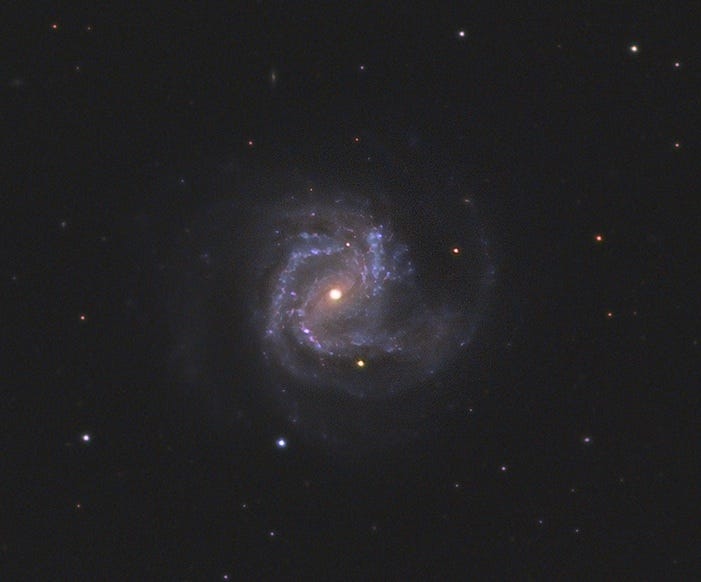
The center of this galaxy is active, emitting high-energy radiation and undergoing a starburst, where somewhere around 100,000 new stars are all forming at once in here! There may even be a second, smaller bar in the very core of this object, causing the starburst to be even more intense. If we look in the infrared, we can see the new, star-forming gas shining more brilliantly than anyplace else in the galaxy.
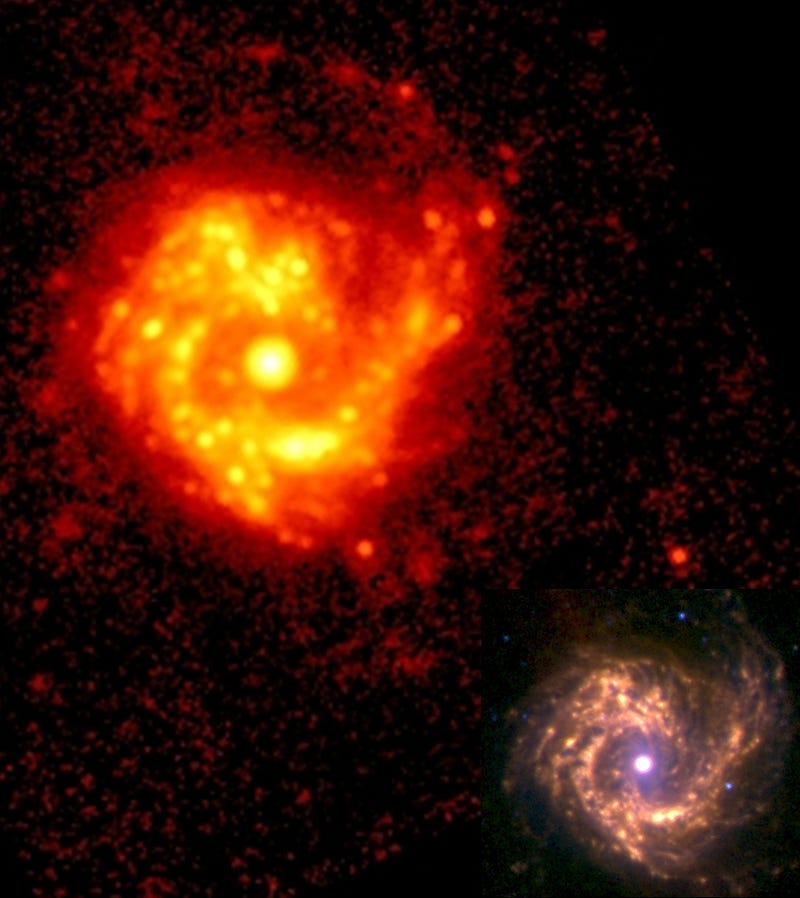
Although there is a supermassive black hole at the center, it’s likely small, estimated to be about 5 million solar masses, or comparable to our own. (Remember, some galaxies have central black holes a thousand times as massive!)
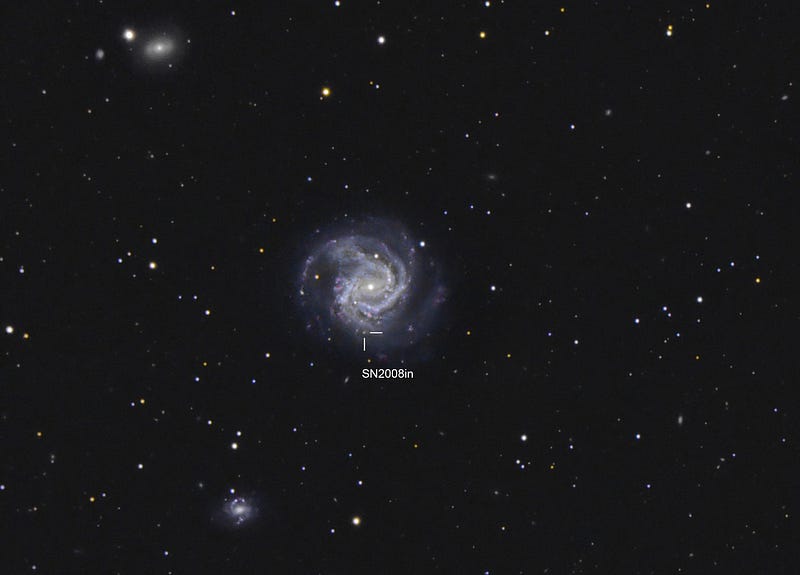
But another telltale sign of this galaxy’s activity is the very large number of supernovae that have been spotted in it: it boasts of six in the last 100 years, leaving it tied for the most found in any Messier object! The most recent one went off just a few years ago in 2008, which is amazing considering our Milky Way has exactly zero occur in it over the same timespan.
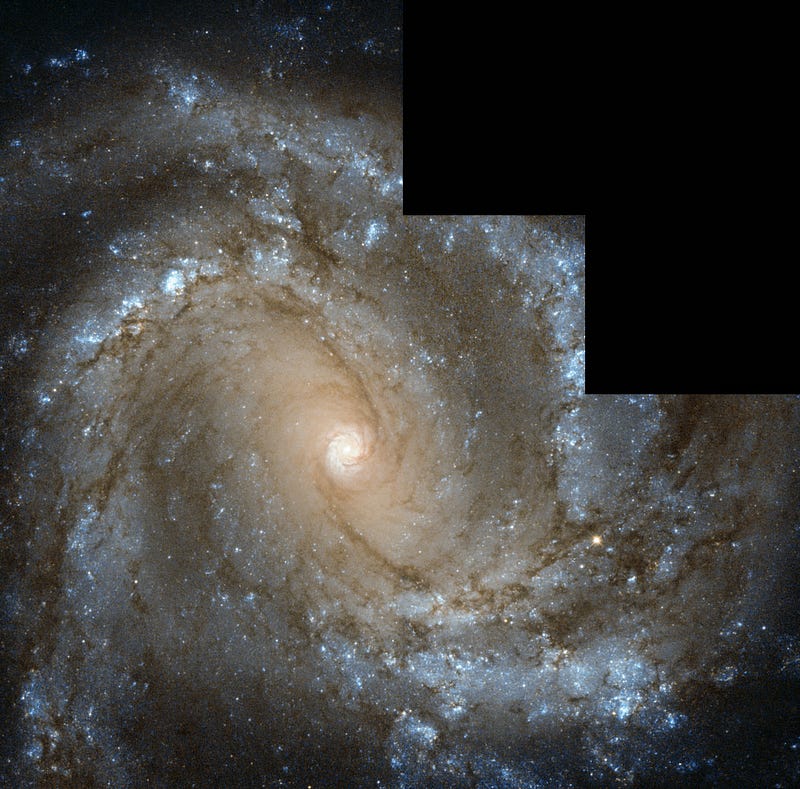
Acknowledgements: G. Chapdelaine, L. Limatola, and R. Gendler.
As is almost always the case, the most spectacular view of this galaxy comes from the Hubble Space Telescope, where the spiral arms stand out brightly against the dusty foreground, and bright blue stars highlight the most recent bursts of new star formation.
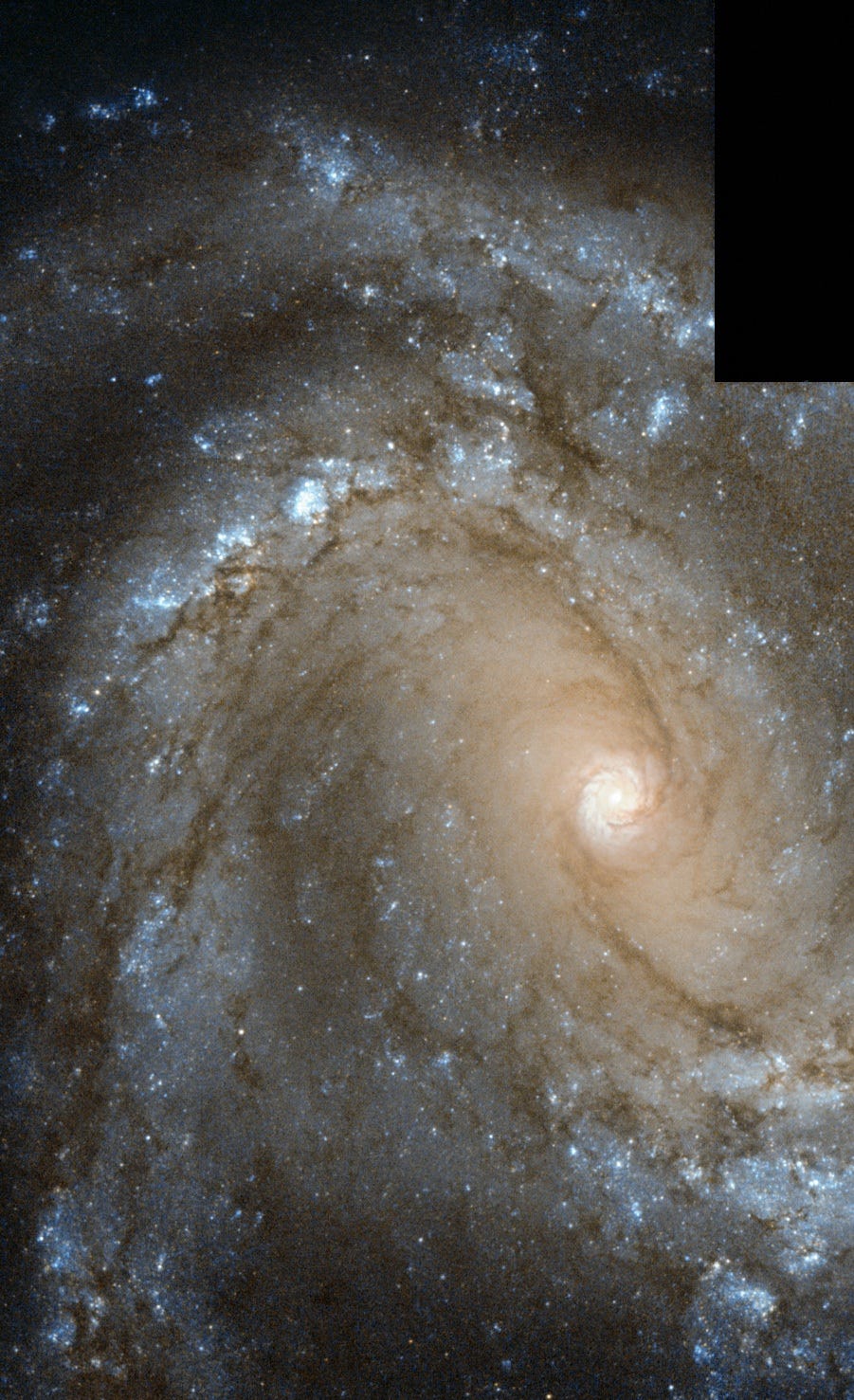
Acknowledgements: G. Chapdelaine, L. Limatola, and R. Gendler.
Unlike many other Messier objects, this one will continue forming hot, young stars for the indefinite future, and should remain a supernova factory for thousands of years! Enjoy your skies tonight, and enjoy the galactic sights that are so rare during a full Moon if your skies allow it!
Enjoy all our previous Messier Mondays here:
- M1, The Crab Nebula: October 22, 2012
- M2, Messier’s First Globular Cluster: June 17, 2013
- M3, Messier’s First Original Discovery: February 17, 2014
- M5, A Hyper-Smooth Globular Cluster: May 20, 2013
- M7, The Most Southerly Messier Object: July 8, 2013
- M8, The Lagoon Nebula: November 5, 2012
- M11, The Wild Duck Cluster: September 9, 2013
- M12, The Top-Heavy Gumball Globular: August 26, 2013
- M13, The Great Globular Cluster in Hercules: December 31, 2012
- M15, An Ancient Globular Cluster: November 12, 2012
- M18, A Well-Hidden, Young Star Cluster: August 5, 2013
- M20, The Youngest Star-Forming Region, The Trifid Nebula: May 6, 2013
- M21, A Baby Open Cluster in the Galactic Plane: June 24, 2013
- M25, A Dusty Open Cluster for Everyone: April 8, 2013
- M29, A Young Open Cluster in the Summer Triangle: June 3, 2013
- M30, A Straggling Globular Cluster: November 26, 2012
- M31, Andromeda, the Object that Opened Up the Universe: September 2, 2013
- M32, The Smallest Messier Galaxy: November 4, 2013
- M33, The Triangulum Galaxy: February 25, 2013
- M34, A Bright, Close Delight of the Winter Skies: October 14, 2013
- M36, A High-Flying Cluster in the Winter Skies: November 18, 2013
- M37, A Rich Open Star Cluster: December 3, 2012
- M38, A Real-Life Pi-in-the-Sky Cluster: April 29, 2013
- M39, The Closest Messier Original: November 11, 2013
- M40, Messier’s Greatest Mistake: April 1, 2013
- M41, The Dog Star’s Secret Neighbor: January 7, 2013
- M42, The Great Orion Nebula: February 3, 2014
- M44, The Beehive Cluster / Praesepe: December 24, 2012
- M45, The Pleiades: October 29, 2012
- M46, The ‘Little Sister’ Cluster: December 23, 2013
- M47, A Big, Blue, Bright Baby Cluster: December 16, 2013
- M48, A Lost-and-Found Star Cluster: February 11, 2013
- M49, Virgo’s Brightest Galaxy: March 3, 2014
- M50, Brilliant Stars for a Winter’s Night: December 2, 2013
- M51, The Whirlpool Galaxy: April 15th, 2013
- M52, A Star Cluster on the Bubble: March 4, 2013
- M53, The Most Northern Galactic Globular: February 18, 2013
- M56, The Methuselah of Messier Objects: August 12, 2013
- M57, The Ring Nebula: July 1, 2013
- M58, The Farthest Messier Object (for now): April 7, 2014
- M60, The Gateway Galaxy to Virgo: February 4, 2013
- M61, A Star-Forming Spiral: April 14, 2014
- M63, The Sunflower Galaxy: January 6, 2014
- M64, The Black Eye Galaxy: February 24, 2014
- M65, The First Messier Supernova of 2013: March 25, 2013
- M66, The King of the Leo Triplet: January 27, 2014
- M67, Messier’s Oldest Open Cluster: January 14, 2013
- M68, The Wrong-Way Globular Cluster: March 17, 2014
- M71, A Very Unusual Globular Cluster: July 15, 2013
- M72, A Diffuse, Distant Globular at the End-of-the-Marathon: March 18, 2013
- M73, A Four-Star Controversy Resolved: October 21, 2013
- M74, The Phantom Galaxy at the Beginning-of-the-Marathon: March 11, 2013
- M75, The Most Concentrated Messier Globular: September 23, 2013
- M77, A Secretly Active Spiral Galaxy: October 7, 2013
- M78, A Reflection Nebula: December 10, 2012
- M79, A Cluster Beyond Our Galaxy: November 25, 2013
- M81, Bode’s Galaxy: November 19, 2012
- M82, The Cigar Galaxy: May 13, 2013
- M83, The Southern Pinwheel Galaxy, January 21, 2013
- M85, The Most Northern Member of the Virgo Cluster, February 10, 2014
- M86, The Most Blueshifted Messier Object, June 10, 2013
- M87, The Biggest One of them All, March 31, 2014
- M88, A Perfectly Calm Spiral in a Gravitational Storm, March 24, 2014
- M92, The Second Greatest Globular in Hercules, April 22, 2013
- M93, Messier’s Last Original Open Cluster, January 13, 2014
- M94, A double-ringed mystery galaxy, August 19, 2013
- M95, A Barred Spiral Eye Gazing At Us, January 20, 2014
- M96, A Galactic Highlight to Ring in the New Year, December 30, 2013
- M97, The Owl Nebula, January 28, 2013
- M98, A Spiral Sliver Headed Our Way, March 10, 2014
- M99, The Great Pinwheel of Virgo, July 29, 2013
- M101, The Pinwheel Galaxy, October 28, 2013
- M102, A Great Galactic Controversy: December 17, 2012
- M103, The Last ‘Original’ Object: September 16, 2013
- M104, The Sombrero Galaxy: May 27, 2013
- M106, A Spiral with an Active Black Hole: December 9, 2013
- M108, A Galactic Sliver in the Big Dipper: July 22, 2013
- M109, The Farthest Messier Spiral: September 30, 2013
And come back next week for yet another! Happy skywatching!
Leave your comments at the Starts With A Bang forum on Scienceblogs.





